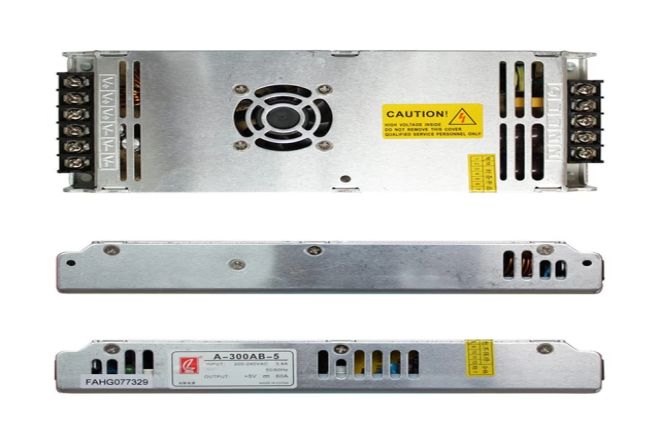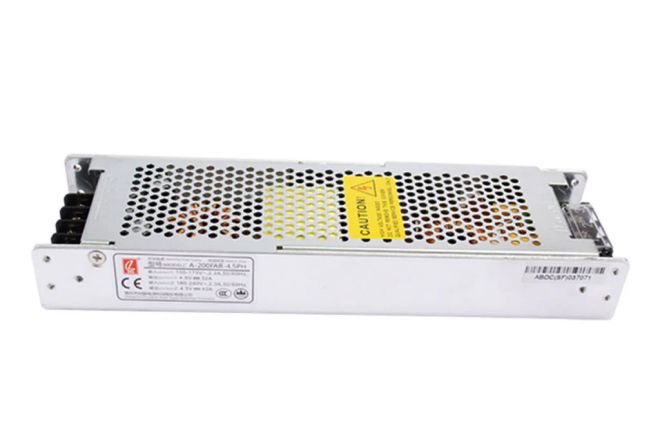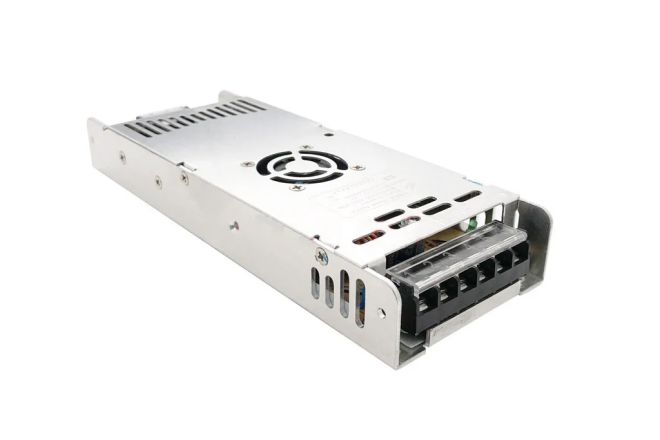مقدمة

من لوحات النيون في المدن الصاخبة إلى المشاهد العاطفية للأحداث الرياضية إلى العرض الدقيق لاجتماعات العمل، شاشات عرض LED أصبحت الوسائط الرقمية حاملة مهمة لدمج نشر المعلومات والفنون البصرية بفضل تأثيرات العرض الممتازة والمرونة العالية وسيناريوهات التطبيق الواسعة.
ومع ذلك، وراء كل هذه الأشياء الرائعة، هناك بطل لا غنى عنه خلف الكواليس - شاشة العرض LED مزود الطاقة، والذي يدعم بصمت التشغيل المستقر للنظام بأكمله ويوفر تدفقًا ثابتًا من الطاقة لكل وليمة بصرية.
إن مصدر الطاقة، باعتباره "قلب" شاشة العرض LED، وأدائه واستقراره مرتبطان بشكل مباشر بتأثير العرض ومستوى استهلاك الطاقة وعمر خدمة شاشة العرض.
لذلك، فإن الفهم العميق لمبدأ العمل وخصائص النوع ونقاط الاختيار وصيانة مصدر طاقة شاشة العرض LED له أهمية كبيرة لضمان التشغيل المستقر طويل الأمد لشاشة العرض وتحسين تجربة المستخدم وتقليل تكاليف التشغيل.
1. المفهوم الأساسي لإمدادات الطاقة لشاشة العرض LED
- التعريف والوظيفة
باختصار، يعد مصدر الطاقة لشاشة العرض LED أحد المكونات الأساسية لتحويل وتوزيع الطاقة. وهو مسؤول عن تحويل التيار المتردد (AC) المستخدم على نطاق واسع، مثل الطاقة في الشبكة المنزلية أو الشبكة التجارية، إلى تيار مستمر (DC) بكفاءة.
تعتبر عملية التحويل هذه بالغة الأهمية لأن حبات مصابيح LED (وحدات إصدار الضوء الأساسية التي تشكل شاشات LED) تتطلب تيارات مباشرة مستقرة لتشغيل الضوء الخاص بها.
لا يكمل مصدر طاقة شاشة LED تحويل الطاقة الكهربائية فحسب، بل يضمن أيضًا توفير جهد وتيار ثابتين ودقيقين لكل حبة مصباح LED من خلال تصميم الدائرة الدقيقة الداخلية لتلبية احتياجاتها من انبعاث الضوء، وبالتالي ضمان سطوع موحد وأداء لون للشاشة بأكملها.
- أهمية
إن استقرار وكفاءة مصدر الطاقة لشاشة LED له تأثير حيوي على الأداء العام للشاشة. أولاً، يمكن لإخراج الطاقة المستقر أن يضمن عدم وميض حبات مصباح LED أو حدوث انحرافات في اللون بسبب تقلبات الجهد أو التيار أثناء التشغيل، وبالتالي الحفاظ على إعادة إنتاج ألوان عالية الدقة للشاشة، مما يسمح للمشاهدين بالاستمتاع بتجربة بصرية حقيقية وحيوية.
ثانيًا، ترتبط كفاءة مصدر الطاقة بشكل مباشر بمستوى استهلاك الطاقة للشاشة. يمكن لمصدر الطاقة الفعال لشاشة LED تقليل فقدان الطاقة أثناء عملية التحويل وتحويل المزيد من الطاقة الكهربائية إلى طاقة انبعاث الضوء من حبات مصباح LED، وبالتالي تقليل استهلاك الطاقة للنظام الإجمالي وتحقيق هدف الحفاظ على الطاقة والحد من الانبعاثات.
وهذا مهم بشكل خاص بالنسبة لشاشات LED الخارجية الكبيرة لأنها غالبًا ما تحتاج إلى التشغيل لفترة طويلة، كما أن استخدام مصادر الطاقة الفعالة يمكن أن يقلل بشكل كبير من تكاليف التشغيل.
بالإضافة إلى ذلك، تعد موثوقية مصدر الطاقة أيضًا أحد العوامل الرئيسية التي تؤثر على عمر الخدمة الطويل لشاشات LED.
يتميز تصميم مصدر الطاقة عالي الجودة بآليات حماية مثالية، مثل حماية الجهد الزائد، وحماية التيار الزائد، وحماية الدائرة القصيرة، وما إلى ذلك، والتي يمكنها قطع خرج الطاقة بسرعة في ظل ظروف غير طبيعية لحماية حبات مصباح LED وأجزاء أخرى من الشاشة من التلف. تضمن هذه الموثوقية العالية أن الشاشة يمكن أن تعمل بثبات في بيئات قاسية مختلفة وتطيل عمرها الافتراضي.
2. نظرة عامة على أنواع مصدر الطاقة لشاشة LED

1) التصنيف حسب جهد الخرج
1.1). مصدر طاقة بجهد ثابت
- سمات:
إن جهد الخرج لمصدر الطاقة ذي الجهد الثابت ثابت، ويظل جهد الخرج ضمن النطاق المحدد مسبقًا بغض النظر عن كيفية تغير الحمل. يعد مصدر الطاقة هذا مناسبًا للمناسبات التي تتطلب استقرار الجهد العالي.
- السيناريوهات القابلة للتطبيق:
على الرغم من أن تطبيق مصدر الطاقة بجهد ثابت في شاشة LED ليس شائعًا مثل مصدر الطاقة بالتيار الثابت، إلا أنه في بعض السيناريوهات المحددة، مثل شرائط إضاءة LED والأضواء الزخرفية وغيرها من المناسبات المستخدمة على التوالي، يمكن لمصدر الطاقة بجهد ثابت تبسيط تصميم الدائرة وتقليل التكاليف.
2) تحليل المزايا والعيوب:
2.1). المزايا: تصميم الدائرة بسيط والتكلفة منخفضة نسبيًا.
- العيوب:
في شاشات العرض LED، بسبب اختلاف انخفاض الجهد بين خرزات مصباح LED وخصائص الدائرة المتسلسلة، قد لا يكون مصدر الطاقة ذو الجهد الثابت قادرًا على ضمان حصول كل خرزة مصباح LED على تيار موحد، وبالتالي التأثير على سطوع وتوحيد الشاشة.
2.2) مصدر طاقة بتيار مستمر
لماذا أصبح الخيار السائد لشاشات العرض LED: تتكون شاشات العرض LED من عدد كبير من خرزات مصباح LED، وقد تختلف الخصائص المضيئة لكل حبة مصباح قليلاً.
يمكن لمصدر الطاقة ذو التيار المستمر أن يضمن حصول كل حبة مصباح LED على تيار مستمر، وبالتالي الحفاظ على استقرار سطوعها ولونها. وهذا أمر ضروري لتحسين تأثير العرض الكلي لشاشة العرض وإطالة عمر خدمة حبة مصباح LED.
2.3). تحليل الميزة:
الاستقرار: يمكن لمصدر الطاقة ذو التيار المستمر أن يضمن أن حبات مصباح LED تحافظ على حالة مضيئة مستقرة لفترة طويلة، مما يقلل من اضمحلال الضوء وتحول اللون.
التوحيد: من خلال توفير تيار مستمر لكل حبة مصباح LED، يمكن لمصدر الطاقة الحالي الثابت ضمان توحيد سطوع شاشة العرض وتحسين التأثير البصري.
وظيفة الحماية: عادةً ما يحتوي مصدر الطاقة الحالي الثابت على وظائف مثل حماية الحمل الزائد وحماية الدائرة القصيرة، والتي يمكنها حماية حبات مصباح LED ومصدر الطاقة نفسه في ظل ظروف غير طبيعية.
2.4) التصنيف حسب مستوى القدرة
مصدر طاقة منخفض الطاقة: يستخدم عادة لتشغيل شاشات العرض LED الصغيرة أو مصابيح LED الفردية. نظرًا لقوته المنخفضة، فإن التكلفة منخفضة نسبيًا، ولكنه قد لا يلبي احتياجات شاشات العرض الكبيرة.
مصدر طاقة متوسط: مناسب لتشغيل شاشات عرض LED متوسطة الحجم أو مجموعة من مصابيح LED. حقق مصدر الطاقة المتوسط توازنًا جيدًا بين الطاقة والتكلفة وهو خيار أكثر شيوعًا في السوق.
مزود الطاقة عالي الطاقة: يستخدم لشاشات العرض LED الكبيرة أو المناسبات التي تتطلب سطوعًا عاليًا. يتمتع مزود الطاقة عالي الطاقة بسعة إخراج قوية واستقرار، لكن التكلفة مرتفعة نسبيًا. عند الاختيار، من الضروري إجراء اعتبارات شاملة بناءً على الاحتياجات الفعلية وميزانية شاشة العرض.
2.5). مصدر طاقة من نوع خاص
مزود طاقة مقاوم للماء: مزود بوظيفة مقاومة للماء، ومناسب لشاشات العرض LED في البيئات الخارجية أو الرطبة. يعتمد مزود الطاقة المقاوم للماء عادةً على مواد تغليف وتصميم هيكلي خاص لضمان التشغيل العادي في البيئات القاسية.
مصدر طاقة قابل للتعديل: مصدر طاقة بجهد خرج أو تيار قابل للتعديل. يعد مصدر الطاقة هذا مفيدًا للغاية في تصحيح أخطاء شاشات العرض LED وصيانتها. يمكن تعديل جهد الخرج أو التيار حسب الحاجة لتلبية متطلبات العرض المختلفة.
باختصار، هناك أنواع مختلفة من مصادر الطاقة لشاشات العرض LED، ويجب النظر في الاختيار بشكل شامل وفقًا للاحتياجات الفعلية وسيناريوهات التطبيق. أصبح مصدر الطاقة ذو التيار المستمر هو الاختيار السائد لشاشات العرض LED نظرًا لمزاياه المستقرة والموحدة
يساعد التصنيف حسب مستوى الطاقة على تحديد مصدر الطاقة المناسب وفقًا لمتطلبات الحجم والسطوع لشاشة العرض؛ وتلبي الأنواع الخاصة من مصادر الطاقة مثل مصدر الطاقة المقاوم للماء ومصدر الطاقة القابل للتعديل متطلبات الاستخدام في بيئات محددة.
3. النقاط الرئيسية لاختيار مصدر الطاقة لشاشة LED
عند اختيار مصدر الطاقة لشاشة LED، عليك مراعاة جوانب متعددة لضمان قدرة مصدر الطاقة على تلبية متطلبات تشغيل الشاشة وأدائها بشكل جيد. فيما يلي بعض نقاط الاختيار الرئيسية:
1) مطابقة الطاقة
- تحديد إجمالي الطلب على الطاقة:
أولاً، من الضروري توضيح إجمالي الطلب على الطاقة لشاشة LED. يعتمد هذا عادةً على عوامل مثل المساحة والدقة وسطوع الشاشة.
بشكل عام، تتراوح قوة المتر المربع من شاشة LED بين 200 وات و1500 وات، ويجب تحديد القيمة المحددة وفقًا للمعلمات المحددة للشاشة.
- اختر مصدر طاقة بقوة مناسبة:
بعد تحديد إجمالي الطلب على الطاقة للشاشة، تحتاج إلى تحديد مصدر طاقة ذو طاقة مطابقة.
يجب أن تكون طاقة مصدر الطاقة أكبر قليلاً من أو تساوي إجمالي الطلب على الطاقة للشاشة لضمان قدرة مصدر الطاقة على تشغيل الشاشة بشكل مستقر وموثوق.
2) الكفاءة وتوفير الطاقة
- أهمية كفاءة التحويل العالية:
يمكن لمصدر الطاقة ذو كفاءة التحويل العالية أن يقلل من فقدان الطاقة أثناء عملية التحويل ويحسن استخدام الطاقة. لذلك، عند اختيار مصدر الطاقة، يجب إعطاء الأولوية للمنتجات ذات كفاءة التحويل العالية. بشكل عام، يجب أن تصل كفاءة التحويل لمصدر الطاقة عالي الجودة إلى أكثر من 80%.
- تصميم موفر للطاقة:
بالإضافة إلى كفاءة التحويل، يمكنك أيضًا الانتباه إلى التصميم الموفر للطاقة لمصدر الطاقة. على سبيل المثال، تحتوي بعض منتجات مصدر الطاقة على وظائف ضبط ذكية، والتي يمكنها ضبط طاقة الخرج تلقائيًا وفقًا للحمل الفعلي لشاشة العرض، وبالتالي تقليل استهلاك الطاقة بشكل أكبر.
3) الاستقرار والموثوقية
- اعتبارات ميزات السلامة:
ترتبط استقرار وموثوقية مصدر الطاقة بشكل مباشر بتأثير التشغيل وعمر خدمة شاشة العرض.
لذلك، عند اختيار مصدر الطاقة، يجب التركيز على ميزات الأمان الخاصة به، مثل الحماية من الجهد الزائد، والحماية من التيار الزائد، والحماية من ماس كهربائي. يمكن لآليات الحماية هذه قطع خرج الطاقة بسرعة في ظل ظروف غير طبيعية لحماية شاشة العرض ومصدر الطاقة نفسه من التلف.
- اختبار الاستقرار:
قبل شراء مصدر الطاقة، يمكنك فهم تقرير اختبار استقرار المنتج أو إجراء اختبارات فعلية. يمكن للاختبار تقييم استقرار وموثوقية مصدر الطاقة أثناء التشغيل على المدى الطويل.
4) فعالية التكلفة
- تحقيق التوازن بين الاستثمار الأولي وتكاليف التشغيل على المدى الطويل:
عند اختيار مصدر طاقة، يجب عليك الموازنة بين الاستثمار الأولي وتكاليف التشغيل على المدى الطويل. على الرغم من أن مصدر الطاقة الذي يتمتع باستثمار أولي أعلى قد يكون له أداء أفضل وعمر خدمة أطول، إلا أنه يجب أيضًا مراعاة تكاليف تشغيله على المدى الطويل. لذلك، عند اختيار مصدر طاقة، يجب عليك مراعاة أدائه وسعره وعمر خدمته وعوامل أخرى.
- تقييم فعالية التكلفة:
من خلال مقارنة منتجات إمداد الطاقة من مختلف العلامات التجارية والنماذج، يمكنك تقييم فعاليتها من حيث التكلفة. إن اختيار المنتجات ذات الفعالية الأعلى من حيث التكلفة يمكن أن يقلل من تكلفة الاستثمار الأولي مع ضمان الأداء.
5) العلامة التجارية وخدمة ما بعد البيع
- اختر علامة تجارية معروفة:
تتمتع العلامات التجارية المعروفة عادةً بجودة منتجات أفضل ونظام خدمة ما بعد البيع أكثر اكتمالاً. إن اختيار منتجات الطاقة من العلامات التجارية المعروفة يمكن أن يقلل من مخاطر الاستخدام ويحسن تجربة المستخدم.
- إنتبه إلى جودة خدمة ما بعد البيع:
عند شراء مصدر طاقة، يجب الانتباه إلى جودة خدمة ما بعد البيع التي يقدمها المصنع. تعرف على سياسة خدمة ما بعد البيع، وتوزيع منافذ الصيانة، ووقت الاستجابة، وغيرها من المعلومات حتى تتمكن من الحصول على الدعم الفني وخدمات الصيانة في الوقت المناسب عند الحاجة.
4. تركيب وصيانة مصدر الطاقة لشاشة LED

1) احتياطات التثبيت
1.1) القدرة على التكيف البيئي
- درجة الحرارة والرطوبة:
يجب التحكم في درجة حرارة بيئة العمل لمصدر الطاقة لشاشة LED ضمن نطاق مناسب. يُنصح عمومًا بأن تكون درجة حرارة العمل المثالية من -20 درجة مئوية إلى 50 درجة مئوية، ويجب الحفاظ على الرطوبة في نطاق الرطوبة النسبية من 10% إلى 90%.
تجنب تعريض الشاشة لدرجات حرارة شديدة أو رطوبة عالية أو بيئات تآكلية لمنع تلف مصدر الطاقة أو تدهور الأداء.
- ظروف التهوية:
تأكد من أن موقع تركيب مصدر الطاقة يتمتع بظروف تهوية جيدة لتجنب ارتفاع درجة حرارة مصدر الطاقة بسبب ضعف تبديد الحرارة، مما يؤثر على استقراره وعمر الخدمة.
1.2) مواصفات الأسلاك
- توصيلات مصدر الطاقة:
وفقًا لمواصفات وكمية الشاشة، احسب طول الكابل المطلوب وكميته، واتبع بدقة مواصفات الأسلاك الخاصة بالأسلاك. يجب أن يكون سلك الطاقة مصنوعًا من منتجات ذات جودة موثوقة وتأكد من أن الاتصال ثابت لتجنب الارتخاء أو حدوث ماس كهربائي.
- توصيل خطوط الإشارة:
يجب أن يضمن توصيل خط الإشارة نقل إشارة مستقر وخالٍ من التداخل. أثناء عملية التوصيل، انتبه إلى نوع الواجهة وطول خط الإشارة، واختر طريقة التوصيل المناسبة، وحاول تجنب الانحناء والالتواء لتجنب إتلاف الخط الداخلي للكابل.
1.3) معالجة التأريض
- أهمية:
نظرًا لأن LED حساس جدًا للكهرباء الساكنة، فإن الكهرباء الساكنة الزائدة ستتسبب في تعطل الصمام الثنائي الباعث للضوء، لذلك يجب توصيل مصدر طاقة شاشة LED بالأرض. يمكن أن يحمي التأريض المعدات من الكهرباء الساكنة والصدمات غير الطبيعية للجهد أو التيار، مما يضمن التشغيل المستقر للشاشة.
- النهج الصحيح:
استخدم السلك ثنائي اللون الأصفر والأخضر المخصص للتأريض لتوصيل وقفل جميع محطات التأريض الكهربائية على التوالي، ثم قم بتوصيلها بمحطة التأريض. إذا لم يكن هناك محطة تأريض في الموقع، فيمكن توصيلها بأنابيب المياه الحديدية أو أنابيب الصرف الصحي الحديدية وغيرها من الأنابيب المدفونة في الأرض وعلى اتصال جيد بالأرض. يجب أن تكون مقاومة التأريض أقل من 4 أوم لضمان تفريغ تيار التسرب في الوقت المناسب.
2) الصيانة اليومية
2.1). تحقق بانتظام من حالة عمل مصدر الطاقة
يجب التحقق بانتظام من أن جهد التيار الكهربائي وخرج التيار الكهربائي طبيعيان لضمان استقرار وموثوقية مصدر الطاقة. في حالة العثور على أي خلل، يجب معالجة مصدر الطاقة على الفور أو استبداله.
2.2) تنظيف نظام التبريد
قم بتنظيف نظام التبريد الخاص بمصدر الطاقة بانتظام، مثل المراوح ومبددات الحرارة والمكونات الأخرى، لمنع تراكم الغبار والحطام والتسبب في ضعف تبديد الحرارة. يمكنك استخدام فرشاة ناعمة لإزالة الغبار برفق وتجنب استخدام المنظفات السائلة لمنع تلف المكونات الداخلية لمصدر الطاقة.
2.3) تجنب ارتفاع درجة الحرارة والتسبب في الأعطال.
تأكد من وجود مساحة تهوية كافية حول مصدر الطاقة لمنع انسداده بواسطة أجهزة أخرى. في بيئات درجات الحرارة المرتفعة أو تبديد الحرارة الضعيف، لا يُنصح باستخدام الشاشة ومصدر الطاقة بشكل مستمر لفترة طويلة لمنع ارتفاع درجة الحرارة والتسبب في الأعطال.
3) استكشاف الأخطاء وإصلاحها
3.1) ظاهرة انقطاع التيار الكهربائي الشائعة
مصباح مؤشر الطاقة مطفأ؛ أو جهد الخرج غير طبيعي؛ أو تومض شاشة العرض أو يكون السطوع غير متساوٍ.
3.2) تحليل السبب
قد لا يضيء مؤشر الطاقة لأن سلك الطاقة فضفاض أو تالف، أو مصدر الطاقة معيب، وما إلى ذلك؛ قد يكون سبب خلل جهد الخرج هو التحميل الزائد للطاقة، أو ارتفاع درجة الحرارة، أو الجهد الزائد أو انخفاض الجهد، وما إلى ذلك؛ قد يكون سبب وميض شاشة العرض أو سطوعها غير المتساوي هو مصدر طاقة غير مستقر أو حبات مصباح LED تالفة، وما إلى ذلك.
3.3) تدابير العلاج الطارئة
أولاً، تحقق مما إذا كان سلك الطاقة متصلاً بإحكام وما إذا كان مقبس الطاقة طبيعيًا؛ ثم تحقق مما إذا كان مؤشر الطاقة وجهد الخرج طبيعيين. إذا كانت هناك مشكلة، فاستبدل مصدر الطاقة في الوقت المناسب؛ وأخيرًا، تحقق مما إذا كانت شاشة العرض وحبات مصباح LED تالفة.
إذا لزم الأمر، قم باستبدالها أو إصلاحها في الوقت المناسب. عند التعامل مع انقطاع التيار الكهربائي، تأكد من إيقاف تشغيل الطاقة لتجنب الصدمات الكهربائية أو تلف المعدات.
خاتمة
مع التقدم المستمر للتكنولوجيا والتطور المستمر للسوق، فإن تقنية إمداد الطاقة لشاشات LED ستفتح أيضًا آفاقًا أوسع للتطوير.
من تصميم إمدادات الطاقة عالية الكفاءة ومنخفضة الطاقة إلى حلول النظام الذكي والوحدات النمطية إلى التطبيق الواسع النطاق للمواد الخضراء والصديقة للبيئة، فإن كل ابتكار تكنولوجي سيضخ حيوية جديدة في صناعة شاشات LED.
أخيرًا، إذا كنت تريد معرفة المزيد عن شاشات LED، يرجى الحصول على اتصال معنا.
